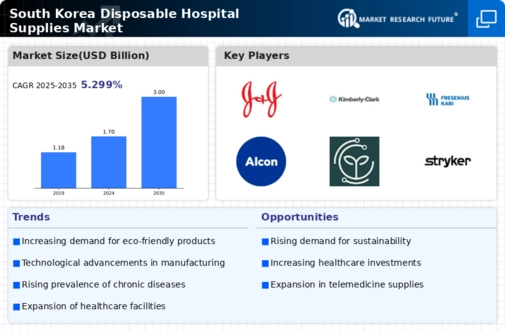Aging Population
The demographic shift towards an aging population in South Korea is a crucial driver for the disposable hospital-supplies market. By 2025, it is estimated that over 20% of the population will be aged 65 and older, leading to increased healthcare needs. Older adults typically require more medical attention, resulting in a higher consumption of disposable supplies such as syringes, gloves, and gowns. This demographic trend suggests a sustained demand for disposable products, as healthcare providers strive to offer adequate care to this growing segment. Additionally, the prevalence of chronic diseases among the elderly population further amplifies the need for disposable hospital supplies, as they are essential for infection control and patient safety. Thus, the aging population is likely to play a pivotal role in shaping the market dynamics.
Rising Healthcare Expenditure
The disposable hospital-supplies market in South Korea is experiencing growth due to the increasing healthcare expenditure. The government has been investing heavily in healthcare infrastructure, which has led to a rise in the demand for disposable supplies. In 2025, healthcare spending is projected to reach approximately $200 billion, reflecting a growth rate of around 6% annually. This increase in funding allows hospitals to procure more disposable products, enhancing patient care and operational efficiency. Furthermore, the emphasis on modernizing healthcare facilities necessitates the use of advanced disposable supplies, which are essential for maintaining hygiene and safety standards. As hospitals expand their services and improve their facilities, the disposable hospital-supplies market is likely to benefit significantly from this trend.
Regulatory Compliance and Standards
The disposable hospital-supplies market is significantly influenced by stringent regulatory compliance and standards set by health authorities in South Korea. The government mandates that healthcare facilities adhere to specific guidelines regarding the use of disposable products to ensure patient safety and minimize infection risks. Compliance with these regulations often necessitates the procurement of high-quality disposable supplies, which can drive market growth. In 2025, it is anticipated that the enforcement of these standards will become even more rigorous, compelling hospitals to invest in reliable disposable products. This regulatory landscape not only enhances the safety of medical procedures but also fosters innovation within the disposable hospital-supplies market, as manufacturers strive to meet evolving standards and consumer expectations.
Increased Awareness of Hygiene Practices
The growing awareness of hygiene practices among healthcare providers and patients is a significant driver for the disposable hospital-supplies market. In South Korea, there is a heightened focus on infection prevention and control, leading to an increased demand for disposable products. Hospitals are implementing stricter hygiene protocols, which necessitate the use of single-use items to minimize cross-contamination risks. This trend is reflected in the market, where the demand for disposable gloves, masks, and gowns is projected to rise by approximately 10% annually. As healthcare facilities prioritize patient safety and infection control, the disposable hospital-supplies market is likely to experience robust growth, driven by the need for reliable and effective hygiene solutions.
Technological Innovations in Manufacturing
Technological innovations in manufacturing processes are reshaping the disposable hospital-supplies market. Advances in materials science and production techniques have led to the development of more efficient and cost-effective disposable products. In South Korea, manufacturers are increasingly adopting automation and smart technologies to enhance production capabilities, which can potentially reduce costs by up to 15%. These innovations not only improve the quality and reliability of disposable supplies but also enable faster response times to market demands. As hospitals seek to optimize their supply chains and reduce operational costs, the adoption of technologically advanced disposable products is likely to gain traction. Consequently, the integration of technology into manufacturing processes is expected to be a key driver of growth in the disposable hospital-supplies market.




















Leave a Comment